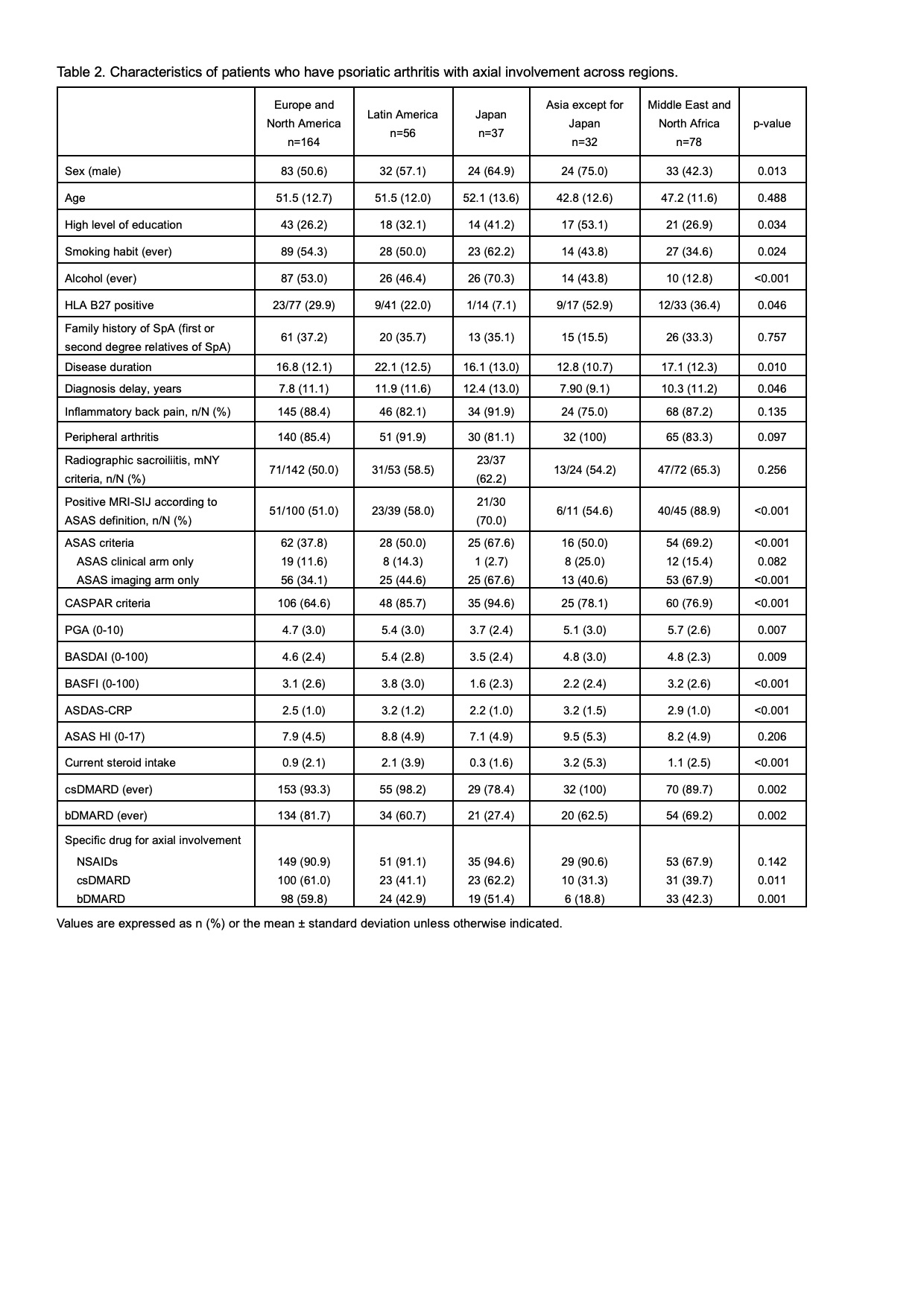Session Information
Session Type: Poster Session D
Session Time: 8:30AM-10:30AM
Background/Purpose: Psoriatic arthritis (PsA) shares genetic and clinical features with other forms of spondyloarthritis (SpA). However, no studies have evaluated regional differences regarding characteristics of PsA with axial involvement (axPsA). The aim of this study is to evaluate regional differences regarding clinical characteristics of axPsA patients.
Methods: Data from the ASAS-PerSpA study, a cross-sectional database recruiting SpA patients between July 2018 and February 2020 from 68 centers worldwide, was analyzed. For this analysis, PsA patients presenting at any time with axial involvement per physician judgement were defined as axPsA. AxPsA was further categorized by 5 regions (Europe and North America, Latin America, Japan, Asia (except for Japan) and Middle East and North Africa). Patient and disease characteristics, activities, and treatments were compared.
Results: Of 4465 SpA patients from the study, 1033 (23.1%) had psoriatic arthritis (PsA). 367 AxPsA patients (35.5% of those with PsA) were compared by region. Percentage of axPsA patients among PsA by region were as follows: 164/489 (34%) from Europe and North America; 56/176 (32%) from Latin American; 37/90 (41%) from Japan; 32/75 (43%) from other Asian countries; and 78/203 (38%) from Middle East and North Africa (Table 1). At 12.4 years (SD 13.0), diagnostic delay in Japan was longer than those in other parts of the world (Table 2). Patients in Europe and North America had less AxSpA, with only 38% fulfilling ASAS AxSpA criteria. Disease activity was lower in Japan with mean ASDAS-CRP score of 2.2 (SD 1.0), despite less frequency of csDMARD (78%) and bDMARD (27%) use. In patients treated specifically for axial involvement, however, AxPsA patients in Japan demonstrated more frequent csDMARD (62%) and bDMARD (51%) use. Both Latin America and Asia showed higher disease activity with mean ASDAS-CRP of 3.2 (SDv1.2) and 3.2 (SD 1.5), respectively; both regions demonstrated less bDMARD use (43% and 19%, respectively) as a specific treatment for axial involvement.
Conclusion: This study suggests axPsA patients demonstrate differing disease manifestations, activities, and treatments by region.
To cite this abstract in AMA style:
Sawada H, Kishimoto M, Tada K, Deshpande G, Kobayashi D, Ono K, Taniguchi Y, Hirata A, Kameda H, Tsuji S, Kaneko Y, Okano T, Haji Y, Dobashi H, Morita A, Asahina A, Okada M, Tomita T, Benavent D, Plasencia-Rodríguez C, Navarro-Compán V, López Medina C, Molto A, van der Heijde D, Dougados M, Tamura N. Regional Differences in Clinical Characteristics and Treatment of Psoriatic Arthritis with Axial Involvement: Results from the Cross Sectional International ASAS PerSpA Study [abstract]. Arthritis Rheumatol. 2021; 73 (suppl 9). https://acrabstracts.org/abstract/regional-differences-in-clinical-characteristics-and-treatment-of-psoriatic-arthritis-with-axial-involvement-results-from-the-cross-sectional-international-asas-perspa-study/. Accessed .« Back to ACR Convergence 2021
ACR Meeting Abstracts - https://acrabstracts.org/abstract/regional-differences-in-clinical-characteristics-and-treatment-of-psoriatic-arthritis-with-axial-involvement-results-from-the-cross-sectional-international-asas-perspa-study/


